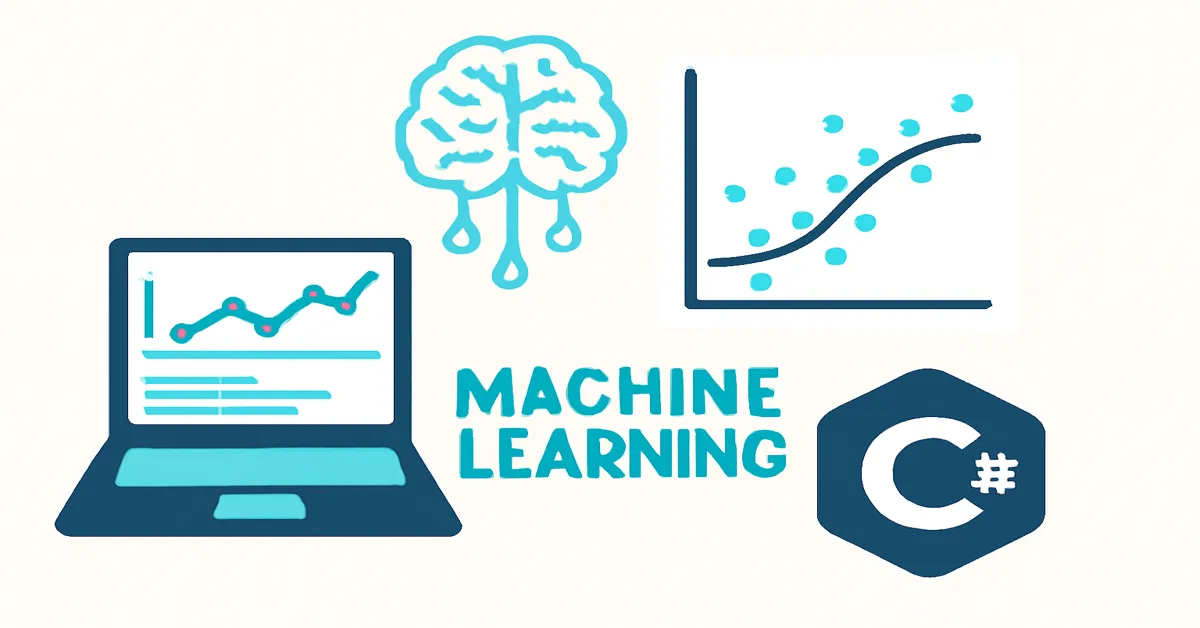Machine learning (ML) has evolved from a niche technology into a cornerstone of modern software development. Today, ML empowers everything from personalized recommendations to predictive analytics and autonomous systems. While Python has traditionally been the lingua franca of machine learning, Microsoft’s ML.NET framework breaks new ground by bringing robust, scalable machine learning capabilities to the .NET ecosystem and developers familiar with C#.
This article serves as a comprehensive guide to getting started with ML.NET, focusing on how to build your first machine learning model using C#. Designed for software engineers, data scientists transitioning to .NET, and tech leaders, it covers foundational concepts, practical steps, and best practices—all updated with the latest advancements as of 2025.
What is ML.NET?
Introduced by Microsoft in 2018, ML.NET is an open-source, cross-platform machine learning framework for .NET developers. Unlike many ML libraries focused on Python or R, ML.NET is designed to fit seamlessly within the .NET ecosystem, enabling developers to build, train, and deploy custom ML models without leaving their preferred environment.
Key Features of ML.NET
- Cross-Platform: Runs on Windows, Linux, and macOS.
- Native C# Integration: Write ML code using familiar C# syntax and tooling.
- Broad Algorithm Support: Includes classification, regression, clustering, anomaly detection, and recommendation algorithms.
- AutoML: Automated machine learning capabilities simplify model selection and tuning.
- Data Loaders and Transformers: Integrates with various data sources and supports feature engineering.
- Extensibility: Ability to integrate TensorFlow, ONNX models, and custom components.
- Model Deployment: Models can be embedded into .NET applications or served via APIs.
Why Use ML.NET?
For .NET-centric organizations and developers, ML.NET offers several compelling advantages:
- No Need to Learn New Languages: Developers proficient in C# can stay productive.
- Integration with Existing .NET Apps: Embed ML capabilities directly into business applications.
- Enterprise-Ready: Backed by Microsoft, ensuring long-term support and scalability.
- Open Source: Community contributions enrich features and keep the framework up to date.
- Customizable: Supports both low-level model training and high-level automated processes.
Prerequisites: What You Need Before Building Your First Model
To follow along, you should have:
- Basic understanding of C# programming.
- Familiarity with machine learning concepts is helpful but not required.
- Visual Studio 2022 or later installed (Community edition works).
- .NET 6.0 SDK or newer.
- Basic understanding of data (CSV or JSON format) is beneficial.
Step 1: Setting Up Your ML.NET Project
Open Visual Studio and create a new Console Application targeting .NET 6.0 or newer:
- File > New > Project
- Select Console App, name it
MLDotNetFirstModel, and click Create. - Add the ML.NET NuGet package: Open the Package Manager Console and run: mathematicaCopy
Install-Package Microsoft.ML
Alternatively, use the NuGet Package Manager GUI to search and install Microsoft.ML.
Step 2: Understanding the Sample Problem — Predicting Housing Prices
We will build a simple regression model that predicts house prices based on features like the number of bedrooms, square footage, and location. This kind of predictive model is common in real estate apps and financial analytics.
Sample Dataset
Our dataset consists of rows with the following columns:
| Bedrooms | Size (sq ft) | Location Score | Price (in $) |
|---|---|---|---|
| 3 | 1500 | 7 | 300000 |
| 4 | 2000 | 8 | 400000 |
| 2 | 900 | 6 | 200000 |
The goal is to train a model that predicts the Price based on the other features.
Step 3: Defining Data Classes
Create two C# classes to represent input data and prediction output.
csharpCopyusing Microsoft.ML.Data;
public class HousingData
{
[LoadColumn(0)]
public float Bedrooms;
[LoadColumn(1)]
public float Size;
[LoadColumn(2)]
public float LocationScore;
[LoadColumn(3)]
public float Price;
}
public class HousingPrediction
{
[ColumnName("Score")]
public float Price;
}
LoadColumnspecifies the column index in the dataset.ColumnName("Score")maps the predicted output to thePriceproperty.
Step 4: Loading and Preparing Data
ML.NET reads data from files like CSV. We will prepare the dataset accordingly.
Place your dataset in a file called housing.csv in the project directory:
Copy3,1500,7,300000
4,2000,8,400000
2,900,6,200000
In the Program.cs, load the data:
csharpCopyusing Microsoft.ML;
using Microsoft.ML.Data;
var mlContext = new MLContext();
IDataView dataView = mlContext.Data.LoadFromTextFile<HousingData>(
path: "housing.csv",
hasHeader: false,
separatorChar: ',');
Step 5: Creating the Data Processing Pipeline
The raw data must be transformed into features that ML algorithms can consume.
csharpCopyvar dataProcessPipeline = mlContext.Transforms.Concatenate(
"Features", nameof(HousingData.Bedrooms), nameof(HousingData.Size), nameof(HousingData.LocationScore))
.Append(mlContext.Transforms.NormalizeMinMax("Features"));
Concatenatecombines multiple input columns into a single feature vector.NormalizeMinMaxscales features to a common range, improving training.
Step 6: Choosing and Training a Regression Algorithm
ML.NET supports multiple regression algorithms. For this example, we use FastTree — a gradient boosting decision tree.
csharpCopyvar trainer = mlContext.Regression.Trainers.FastTree(labelColumnName: "Price", featureColumnName: "Features");
var trainingPipeline = dataProcessPipeline.Append(trainer);
var model = trainingPipeline.Fit(dataView);
This trains the model on the dataset.
Step 7: Evaluating the Model
Split the data into training and testing sets for evaluation.
csharpCopyvar split = mlContext.Data.TrainTestSplit(dataView, testFraction: 0.2);
var trainedModel = trainingPipeline.Fit(split.TrainSet);
var predictions = trainedModel.Transform(split.TestSet);
var metrics = mlContext.Regression.Evaluate(predictions, labelColumnName: "Price");
Console.WriteLine($"R^2: {metrics.RSquared:0.##}");
Console.WriteLine($"RMSE: {metrics.RootMeanSquaredError:#.##}");
- R² (Coefficient of Determination): Measures how well the model predicts variance (closer to 1 is better).
- RMSE (Root Mean Squared Error): Average prediction error; lower is better.
Step 8: Making Predictions with the Model
Use the model to predict prices for new houses:
csharpCopyvar predictionEngine = mlContext.Model.CreatePredictionEngine<HousingData, HousingPrediction>(model);
var newHouse = new HousingData { Bedrooms = 3, Size = 1600, LocationScore = 7 };
var prediction = predictionEngine.Predict(newHouse);
Console.WriteLine($"Predicted price: ${prediction.Price:0.##}");
Step 9: Saving and Loading Your Model
Persist the trained model for reuse:
csharpCopymlContext.Model.Save(model, dataView.Schema, "HousingModel.zip");
ITransformer loadedModel = mlContext.Model.Load("HousingModel.zip", out var modelInputSchema);
This allows deployment without retraining.
Beyond the Basics: What’s Next in ML.NET?
AutoML: Automated Model Selection and Tuning
ML.NET’s AutoML simplifies model building by automatically selecting algorithms and hyperparameters, ideal for newcomers.
Integration with ONNX and TensorFlow
Use pre-trained models or custom deep learning models by importing ONNX or TensorFlow formats, extending ML.NET’s capabilities.
Custom Transforms and Featurizers
Implement domain-specific data transformations or feature extractors using custom components.
Real-Time and Batch Predictions
Deploy ML models within .NET APIs or services for real-time inference or process large datasets in batch.
Common Pitfalls and Best Practices
- Data Quality: Ensure your data is clean and representative.
- Feature Engineering: Experiment with feature transformations and selections.
- Train-Test Split: Always evaluate on unseen data to avoid overfitting.
- Model Interpretability: Use tools to understand model predictions, especially in business-critical apps.
- Performance Tuning: Adjust hyperparameters and experiment with different algorithms.
Real-World Applications of ML.NET
- Finance: Fraud detection, risk analysis.
- Retail: Demand forecasting, customer segmentation.
- Healthcare: Predictive diagnostics.
- Manufacturing: Predictive maintenance.
Its .NET foundation makes it attractive to enterprises already invested in Microsoft’s ecosystem.
The Future of Machine Learning with ML.NET and C#
With continual improvements, tighter integration with Azure cloud, and expanding algorithm support, ML.NET is poised to empower .NET developers to build smarter, data-driven applications easily.
Microsoft’s investments in ML.NET reflect a vision of democratized AI accessible directly within mainstream development workflows.
Conclusion
Building your first machine learning model with ML.NET and C# is both accessible and powerful. By leveraging familiar tools, developers can create predictive, data-driven applications without the steep learning curve traditionally associated with machine learning.
From loading data, processing features, training models, to making predictions, ML.NET offers a comprehensive yet approachable toolkit for integrating AI into .NET applications.
For developers eager to embrace AI in 2025 and beyond, ML.NET is a compelling platform to start that journey — unlocking the potential of machine learning with the elegance of C#.
Read:
The 10 Best Programming Books for Beginners: Your Roadmap to Learning Code
FAQs
1. What is ML.NET and who should use it?
Answer: ML.NET is a Microsoft open-source machine learning framework for .NET developers, ideal for those who want to build ML models using C# without switching languages.
2. Do I need prior machine learning experience to use ML.NET?
Answer: No, ML.NET offers beginner-friendly tools like AutoML that simplify model building, making it accessible to developers new to machine learning.
3. Can ML.NET handle different types of machine learning tasks?
Answer: Yes, ML.NET supports classification, regression, clustering, anomaly detection, recommendation, and supports integration with TensorFlow and ONNX models.
4. How do I train and evaluate a model in ML.NET?
Answer: You load data, define a data processing pipeline, select and train an algorithm, then evaluate performance metrics like R² and RMSE on test data.
5. Can ML.NET models be deployed in production applications?
Answer: Absolutely. ML.NET models can be saved, loaded, and integrated seamlessly into .NET applications for real-time or batch predictions in production environments.











